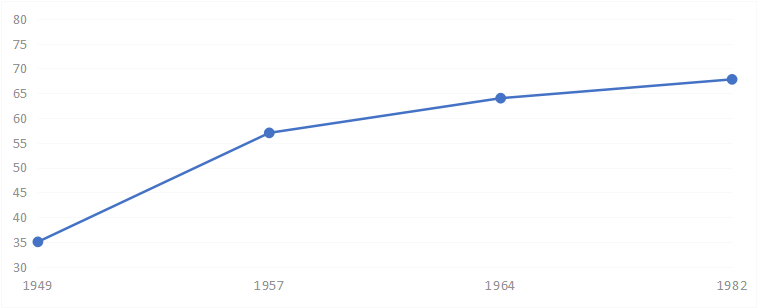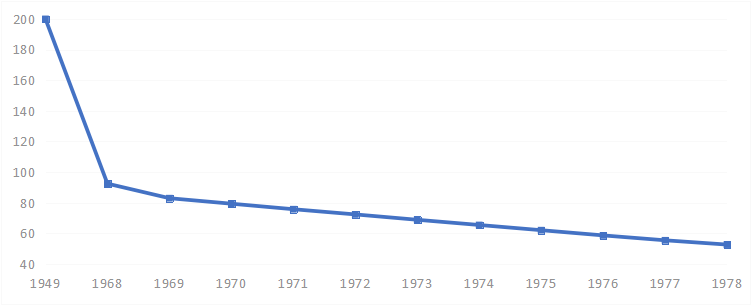Public Health, Elementary Education and Infrastructure Constitutes the Foundation of Future Economic Development
Here is an excerpt from Economic Lessons from 70 Years of China’s Development.
Public Health
In the early years of the People’s Republic of China, war, famine and infectious diseases made it difficult to ensure the basic health level of the people. In 1949, the average life expectancy in China was only 35 years, and the infant mortality rate was as high as 200‰1. Faced with such rigorous challenges and the lack of medical resources, China urgently needed to build a public health system to solve the most basic medical problems of the people. In order to establish a public health system, the government increased investment in the field of healthcare. As shown in the table below, in 1952, the government spent RMB386 million on health, accounting for 0.68% of the financial expenditure; in the subsequent 30 years, the government’s health expenditure increased significantly, reaching RMB3.544 billion in 1978, accounting for 3.16% of the financial expenditure. Compared with developed countries, this level of investment lagged considerably behind, but in the context of China’s economic situation at that time, this investment helped lay an economic foundation for China to establish a public health system, signifying the government’s emphasis on people’s health.
Exhibit 11 Chinese Government’s Health Expenditure during 1952-1978
Year | Government Health Expenditure (in RMB100 million) | As a percentage of Financial Expenditure (%) | As a percentage of GDP (%) |
1952 | 3.86 | 0.68 | 0.57 |
| 1953 | 5.37 | 0.93 | 0.65 |
| 1958 | 5.92 | 0.91 | 0.45 |
| 1963 | 10.83 | 1.59 | 0.88 |
| 1968 | 11.96 | 1.54 | 0.69 |
| 1973 | 21.92 | 2.49 | 0.81 |
| 1978 | 35.44 | 3.16 | 0.97 |
Data source: DU Lexun, ZHAO Yuxin and LIU Guoxiang, 2009: Review and Prospect of Government Health Expenditure and Total Health Expenditure Accounting in the 60 Years since the Founding of the People’s Republic of China, published on Chinese Journal of Health Policy, 10th issue
Given the shortage of medical resources, how to maximize the results with limited input became the key problem to be solved by China’s public health system. Therefore, China must adopt public health measures unique to it. In the process of establishing a public health system, China adopted three key measures: 1. establishing a health policy focusing on prevention; 2. improving health level through “Patriotic Health Campaign”; and 3. establishing a cooperative medical care system to provide basic medical services to farmers.
Different from the western health system focusing on treatment, China put forward the health policy focusing on prevention based on the actual basic medical conditions at that time, and invested limited human, financial and material resources into prevention, achieving remarkable results. To protect the people from rampant infectious diseases, the government provided a variety of prophylactic vaccines against smallpox, diphtheria, tuberculosis and other diseases. For example, smallpox, a virulent infectious disease that raged in the early days of the People’s Republic of China, had a death rate of up to 25%, and it broke out almost every year in many parts of the country. In 1950, the Ministry of Health issued the Interim Measures for Vaccination, promoting free vaccination throughout the country. It was reported that from 1949 to 1952, more than 500 million people were vaccinated against smallpox. Every year, the country provided more than 100 million smallpox vaccines free of charge and various medical appliances needed for vaccine injection, thus effectively reducing the infection of smallpox and basically eliminating smallpox in the 1960s. It was exactly because of the adoption of a health policy focusing on prevention that China significantly controlled and reduced the incidence of smallpox, plague, schistosomiasis, cholera and other severe infectious diseases in the first decade after the founding of the People’s Republic of China, greatly improving the people’s health.
At the same time, China launched a “Patriotic Health Campaign” to motivate the people to devote themselves to the construction of the national public health system. Between 1949 and 1952, under the leadership of the Central Committee of Epidemic Prevention, a new upsurge of mass health campaign, namely, “Four Pests Campaign”, was rapidly launched in various regions. In the first half of 1952 alone, more than 15 million tons of garbage was cleared, 280,000 kilometers of channels were dredged, 4.9 million new toilets were built, and over 1.3 million wells were rebuilt. The active participation of the people helped improve the sanitary environment significantly, enhance the health awareness of the people, and fulfill the purpose of preventing and reducing diseases, which reflected the characteristics of China’s public health work.
In the early days after the founding of the People’s Republic of China, 85% of the people lived in rural areas, so it was particularly important to solve the problem of medical security for this large population. In the mid-1950s, many cooperatives tried to establish a cooperative health care system to finance and pay for preventive services, basic health care, and disease treatment for farmers. The cooperative medical system provided health education, family planning, preventive inoculation, surveillance and reporting of infectious diseases and other preventive services for farmers. At the same time, the cooperative medical system is equipped with basic medical equipment and medicines, so that farmers can access and afford medical services, thus effectively ensuring the health level of farmers. By 1976, 93% of the people’s communes in China managed to establish a cooperative medical care system.
It was precisely because of China’s investment in health care in the first 30 years after the founding of the People’s Republic of China and the adoption of public health measures with Chinese characteristics that China’s public health system and medical service system were constantly improved and achieved remarkable results. As shown in the table below, from 1949 to 1982, the average life expectancy in China increased from 35 years to 68 years, nearly doubling. Meanwhile, the infant mortality rate dropped from 200‰ in the early days of the founding of the People’s Republic of China to 53‰ in 1978. People’s health level was significantly improved, and the improvement of population health level in turn provided important human resource guarantee for social and economic development (Gourdel et al., 2004), and people’s quality of life was also improved greatly. At the same time, China has also abandoned the traditional “western model” of public health, and developed an internationally recognized and successful public health system in an efficient manner with limited resources, which is of great referential significance to other developing countries.

Exhibit 12 Average Life Expectancy in China during 1949-1982
Data source: National Bureau of Statistics and China’s previous census data

Exhibit 13 Infant Mortality Rate (‰) during 1949-1978
Data source: National Bureau of Statistics, Wind database and ACCEPT
1.Data source: National Bureau of Statistics




